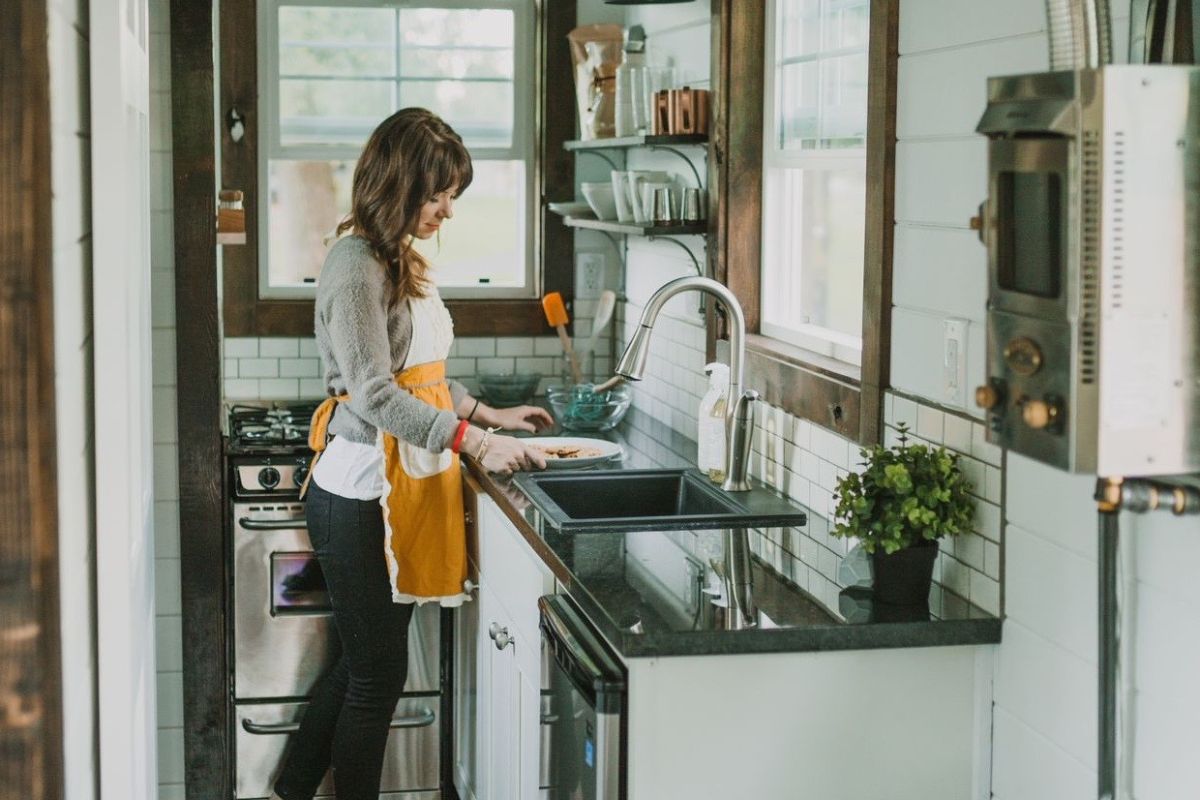How to Get Hot Water in a Tiny Home: Best Options for Small Spaces
.jpg)
To get hot water in your tiny home, opt for space-saving solutions like tankless or compact electric water heaters, which heat water on demand or store just enough for daily needs. Propane water heaters work great for off-grid setups, while solar or portable options are ideal for eco-friendly or flexible hot water access. Size your system based on your actual usage to maximize efficiency. Wondering how to choose the perfect fit or boost energy savings? Here's what to contemplate next.
- Tankless water heaters provide endless hot water on demand and save space, making them ideal for tiny homes.
- Compact electric water heaters can fit under sinks or cabinets and efficiently serve low to moderate hot water needs.
- Propane water heaters are great for off-grid or mobile tiny homes, offering efficient heating and easy installation.
- Solar water heaters use free energy from the sun and can lower utility bills if your tiny home gets good sun exposure.
- Portable water heaters offer flexible, temporary hot water solutions for outdoor showers or remote setups in tiny living spaces.
Understanding Your Hot Water Needs in a Tiny Home
How much hot water do you actually need in your tiny home? Start by listing all the ways you’ll use hot water—showers, washing dishes, laundry, and handwashing. Estimate how many gallons each activity requires daily. For example, a quick shower may use around 10 gallons, while washing dishes might need 2–4 gallons. Multiply each use by the number of people in your home. Consider your lifestyle, too—do you take long showers or use water-saving habits? Factor in guest visits and seasonal needs. By calculating your daily and peak hot water demand, you’ll avoid oversizing or undersizing your system. This step guarantees you choose a water heating solution that fits your space, budget, and energy resources without waste or shortage.
Tankless Water Heaters: Space-Saving Efficiency
With their compact design and on-demand performance, tankless water heaters fit seamlessly into tiny homes where every inch matters. Unlike bulky tanks, these systems mount on a wall and only heat water when you turn on the tap, saving both space and energy. You’ll never run out of hot water during a shower, and you’re not wasting energy keeping a tank heated all day.
When choosing a tankless model, consider your home’s water usage and flow rate needs. Look for units with reliable temperature controls and energy efficiency ratings. Installation usually requires a professional, especially if you’re dealing with gas lines or electrical upgrades. Regular maintenance, like descaling, keeps your system running smoothly. With the right model, you’ll enjoy comfort while maximizing every square foot.

Compact Electric Water Heaters for Small Spaces
Not every tiny home needs the instant hot water of a tankless system—sometimes a compact electric water heater offers a better fit. These small units store a few gallons of hot water, making them ideal if you have moderate demands and want a simple installation. You can tuck one under a sink or in a cabinet, saving precious floor space. Most models plug directly into standard outlets, so you don’t need special wiring. To choose the right size, estimate your peak usage—washing dishes and quick showers are manageable with a 2.5–6 gallon tank. Insulate pipes to minimize heat loss and consider a timer for efficiency. If you’re connected to grid power and want straightforward hot water, a compact electric heater serves you well.
Propane Water Heaters: Off-Grid Hot Water Solutions
When you’re living off-grid or want a reliable backup, propane water heaters deliver hot water without relying on electricity. These units are perfect for tiny homes since they’re compact, efficient, and easy to install. You’ll find tankless models especially useful—they heat water on demand, so you won’t waste energy storing hot water you don’t need. Mount the heater near your shower or sink for quick access, and use proper venting to guarantee safe operation.
Refillable propane tanks are easy to swap out, making this option convenient for remote locations. Always check local codes before installation, as safety standards can vary. Regularly inspect connections for leaks, and keep a carbon monoxide detector nearby for peace of mind. With propane, you get consistent hot water, anywhere.
Solar Water Heaters for Eco-Friendly Living
If you’re looking to reduce your environmental footprint while still enjoying hot showers, solar water heaters offer a smart solution for tiny homes. These systems use energy from the sun to heat water, so you’ll cut down on utility bills and reliance on fossil fuels. You can choose between active solar heaters, which use pumps to circulate water, or passive models that rely on gravity. Install solar panels on your roof or in a sun-exposed area for maximum efficiency. Insulate your water tank and pipes to prevent heat loss, especially in cooler climates. Maintenance is minimal—just keep the panels clean and check for leaks. Solar water heaters work best if your site gets plenty of sunlight, so consider your location before investing.
Portable Water Heaters for Flexibility and Mobility
While maximizing space and keeping things simple is key in a tiny home, portable water heaters give you the flexibility to enjoy hot water wherever you need it. These compact units are easy to move and set up, making them perfect for off-grid living, outdoor showers, or even washing dishes outside. You’ll find models powered by propane, electricity, or batteries, so you can choose one that fits your power setup best. Look for a unit with adjustable temperature controls and built-in safety features. Always check the flow rate and tank size to match your needs—smaller tanks heat water faster but offer less at a time. Remember to follow manufacturer guidelines for ventilation and placement to guarantee safe, efficient operation in your tiny home.
Integrating Hot Water With Your Heating System
Beyond portable solutions, you can create even more efficiency in your tiny home by tying your hot water supply directly into your main heating system. Many tiny homeowners integrate a combi-boiler or hydronic heating system, which delivers both space heating and hot water from a single unit. With this setup, you’ll reduce equipment footprint and maintenance demands. To get started, assess whether your current heating system can be adapted for domestic hot water. If not, consider upgrading to a combination unit designed for both uses. Prioritize systems compatible with your home’s energy source—electric, propane, or natural gas. Work with a qualified installer to guarantee safe, code-compliant connections. With proper integration, you’ll enjoy steady hot water and a streamlined, energy-smart solution tailored for small spaces.
Tips for Maximizing Hot Water Efficiency in Tiny Homes
To make the most of limited resources in a tiny home, focus on strategies that boost your hot water efficiency without sacrificing comfort. Start by installing low-flow showerheads and faucets to cut water use without reducing pressure. Insulate your hot water pipes to minimize heat loss on the way to your tap. Set your water heater temperature to 120°F—hot enough for comfort, but not so high that it wastes energy or risks scalding. Only run your water heater when needed if you use an on-demand or tankless system. Fix leaks promptly, as even small drips add up. Finally, try to schedule hot water use—like showers and dishwashing—close together so the system works more efficiently and doesn’t reheat water between uses.
Conclusion
No matter your lifestyle or setup, you’ve got plenty of great options to get reliable hot water in your tiny home. Whether you go tankless, electric, propane, solar, or portable, there’s a solution to fit your space and needs. Take time to assess your usage, budget, and energy preferences. By picking the right system and maximizing efficiency, you’ll enjoy comfort without sacrificing space. Hot showers and efficient living can absolutely go hand-in-hand!









